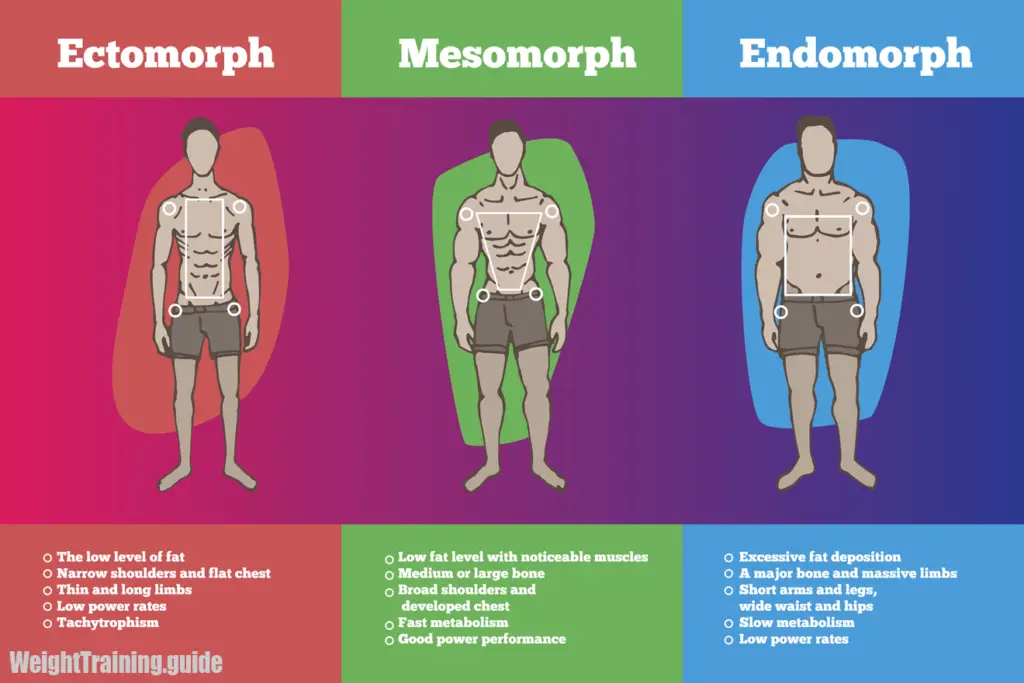Training for your body type: endomorph, mesomorph, or ectomorph
Key takeaways
- Understanding your body type can help you train more efficiently.
- The most common body types are endomorph, mesomorph, and ectomorph.
- Endomorphs tend to have larger bone structure, mesomorphs naturally have more muscular builds, while ectomorphs are slimmer.
Endomorph, mesomorph, or ectomorph?
Understanding your body type can significantly enhance your fitness journey by helping you customize your workouts and nutrition. The concept of body types, or somatotypes, was introduced by psychologist William Sheldon in the 1940s, categorizing individuals into three primary types: endomorph, mesomorph, and ectomorph. While most people are a blend of these types, identifying your dominant traits can guide you in optimizing your training and diet for better results in muscle gain or fat loss.

The endomorph
Endomorphs tend to have a larger bone structure, higher fat storage, and a slower metabolism. This body type is often characterized by a rounder physique and a tendency to gain weight easily, making fat loss more challenging but not impossible.
Optimizing training for endomorphs
To counterbalance the slower metabolism, endomorphs benefit from a combination of cardiovascular exercise and strength training. High-intensity interval training (HIIT) is particularly effective because it boosts metabolism for hours after the workout. Strength training should focus on compound movements like squats, deadlifts, and bench presses to engage multiple muscle groups and burn more calories.
Tailoring nutrition for endomorphs
Endomorphs often need to pay closer attention to their carbohydrate intake. A diet focused on lean proteins, healthy fats, and complex carbohydrates in moderation can help regulate insulin levels and support fat loss. Intermittent fasting or carb cycling can also be effective strategies to manage weight.
The mesomorph
Mesomorphs are often described as having the ideal body type for bodybuilding. They have a naturally muscular physique, broad shoulders, narrow waists, and a balanced metabolism. They can gain muscle easily and lose fat with relative ease, making them highly adaptable to various fitness goals.
Strength training for mesomorphs
Since mesomorphs respond well to resistance training, they can thrive with moderate to heavy lifting. Incorporating a mix of hypertrophy (muscle growth) training with moderate repetitions (8–12 reps) and strength training with lower reps (4–6 reps) can maximize both muscle size and strength. Including some cardiovascular training helps maintain leanness and cardiovascular health without compromising muscle gains.
Nutrition tips for mesomorphs
A balanced diet with a good ratio of protein, carbohydrates, and healthy fats is crucial. Since mesomorphs have an efficient metabolism, they can often handle a higher carbohydrate intake without excessive fat gain. Ensuring regular meals that prioritize whole foods will help them maintain energy for intense training sessions.
The ectomorph
Ectomorphs are characterized by a slim, lean build, long limbs, and a fast metabolism. They often struggle to gain weight or muscle mass, making it essential to focus on calorie-dense nutrition and strength-focused training to achieve their goals.
Effective training for ectomorphs
For ectomorphs, the primary focus should be on resistance training with heavy weights and lower repetitions (6–8 reps per set). Compound movements like squats, deadlifts, and bench presses are essential for maximizing muscle activation. Rest between sets should be slightly longer (about 90–120 seconds) to allow for heavier lifting. Cardio should be minimal to avoid burning additional calories, which can hinder weight gain.
Nutritional strategies for ectomorphs
Ectomorphs need to consume more calories than they burn to see significant muscle growth. Emphasizing calorie-dense foods like nuts, avocados, and lean proteins, along with complex carbohydrates such as oats and sweet potatoes, can help meet their energy needs. Eating frequent meals and incorporating post-workout shakes rich in protein and carbohydrates can further support muscle building.
Blended body types: customizing your approach
Many people are not purely one body type but rather a combination of two. For example, an ecto-mesomorph may have a lean frame but gain muscle relatively easily, while an endo-mesomorph might have a larger frame with more muscle mass but still struggle with fat loss. Understanding your unique blend allows you to fine-tune your training and nutrition strategies.
The psychological benefits of training for your body type
Beyond the physical benefits, tailoring your fitness routine to your body type can enhance your mental well-being. It reduces frustration from unrealistic expectations and allows you to focus on what your body can achieve. Embracing your natural physique while working toward your goals fosters a positive relationship with fitness and body image.
Embrace your unique body type
Whether you’re an endomorph, mesomorph, ectomorph, or a blend, understanding your body type can empower you to train smarter and achieve your fitness goals more efficiently. By aligning your workout routines and nutrition plans with your somatotype, you can unlock your body’s full potential, making the journey toward fat loss or muscle gain more effective and sustainable.
Written with assistance from AI. Reviewed and edited by Marielle Livelo.







